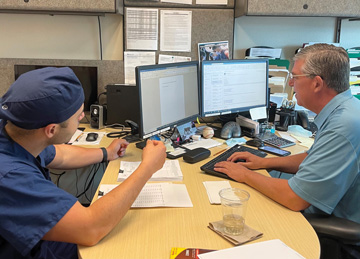A handheld ultrasound system, such as the one Dr. Durick used to prevent an unnecessary case cancellation, costs as little as a few thousand dollars. Rather than waiting until an ultrasound system that is being used to place a block becomes available,
handheld devices allow providers to determine critical information about patients in an instant. “You can place the probe on the patient’s stomach and determine within seconds what their aspiration risk is,” says Dr. Durick.
“You can determine whether the patient had clear liquids, thick liquids or solids, and change the anesthesia plan accordingly. This can prevent complications and case cancellations.”
Mike MacKinnon, DNP, FNP-C, CRNA, an anesthesia provider at Northeastern Anesthesia in Show Low, Ariz., is a proponent of handheld ultrasound and believes more anesthesia professionals will tap into the technology as younger providers enter the
field. He serves as an assistant program director at a local teaching program where all anesthesia residents receive smartphone-integrated ultrasound devices. “We train them with these units right from the beginning, and the technology
is integrated into the program the entire way through,” he says.
Drs. Durick and MacKinnon point to a key alternative use for handheld ultrasound technology: helping staff manage difficult IV starts. The system Dr. Durick uses features biplane technology, which allows him to see both the short and long axis
at the same time and on one screen. “You can see your needle coming in on two planes, making it nearly impossible to miss the blood vessel,” he says. This miss-prevention technology leads to higher rates of first-stick success,
which saves providers valuable time and prevents patients from experiencing unnecessary pain and stress before surgery.
Handheld ultrasound is only one of many innovative technologies that allow providers to achieve safer and higher-quality outcomes. Here are several other developments in the field that continue to advance anesthesia care.
• Targeted pain relief. Ultrasound-guided regional anesthesia helps providers place safer and more effective blocks by letting them infiltrate the anesthetic more precisely around targeted nerve bundles. “Ultrasound also helps
you identify the danger zones, the places you don’t want to put the needle — the veins and the actual nerve sites,” says Dr. MacKinnon.
But it’s the combination of proper training and ultrasound technology that really excites Dr. MacKinnon. “Providers who continue to train with ultrasound have fewer failed and patchy blocks, utilize less local anesthetic and achieve
longer block times because the technology allows them to clearly see the needle and the nerve,” he says.
The most exciting part of ultrasound is the competition among manufacturers that leads to innovative, less expensive platforms. “Every year, when I see the latest offerings at trade shows, new devices are launched that are better than previous
versions,” says Dr. MacKinnon. He adds that features such as high-frequency imaging that provide clearer images, along with needle enhancement and needle-guidance capabilities, make the newer models more user-friendly and allow providers
to place more precise blocks.
High-performance ultrasound models are helping to advance regional anesthesia techniques. Dr. Durick points out that iPACK and PECS 1 and 2 blocks are being performed with increased regularity. He says the iPACK block, which involves infiltrating
the tissue plane between the popliteal artery and the capsule of the knee, is used in combination with other blocks to manage pain in joint replacement patients. The PECS 1 and 2 blocks are used for breast, chest wall and axillary procedures.
Providers who continue to train with ultrasound have fewer failed and patchy blocks, can utilize less local anesthetic and achieve longer block times.
— Mike MacKinnon, DNP, FNP-C, CRNA
“These newer blocks, as well as more established blocks, should be used whenever they are available, unless there are contraindications,” says Dr. Durick. “They should be combined with multimodal analgesia to minimize opioid
requirements, provide better postoperative pain relief and allow patients to recover at home.”
The long-lasting relief of effective regional anesthesia can be extended with the use of “smart” pain pumps, devices that allow providers to pre-program the administration rates and timing of local anesthetics while also giving patients
the ability to self-administer dosages within a set limit. What’s more, some of the newer smart pumps can collect user data and allow providers to monitor patient recoveries in real time, which can potentially improve postoperative pain
control. For instance, a patient who is continually pushing the button on their pump to give themselves a bolus of pain-relieving medication could prompt a call from their provider to see if the treatment plan can be adjusted.
• Improved airway management. Several vendors have integrated video bronchoscopy capabilities into their video laryngoscope systems, says Dr. Durick. “Most of these are single-use bronchoscopes that are intended for unplanned
difficult intubations and intentionally awake fiberoptic intubations,” he says.
The technology allows you to add this invaluable airway management tool to your anesthesia toolkit or upgrade your old system to use a video laryngoscope or flexible fiberoptic bronchoscope with immediate changeover. That means anesthesia providers
don’t need to grab a second imaging tower, light source and screen, points out Dr. Durick. “Having both systems immediately available can be life-saving in an airway emergency,” he says.
• Integrated information. There are an array of app-based platforms on the market that interface with EMRs to streamline the gathering of preoperative information from patients. The platforms automatically populate medical records
and effectively root out inefficiencies and issues that could lead to delays and case cancellations in a variety of ways.
Dr. Durick’s facility is currently evaluating several systems that minimize the amount of time staff spends asking repeated questions about a patient’s smoking status, anesthesia history, medications, allergies and difficult airway
risk, and automatically push out reminders to patients about tasks they must complete before surgery — for example, continue to take blood pressure medications or don’t smoke or vape during the 24 hours leading up to their procedures
— to prevent delays or minimize adverse reactions to anesthesia. He says the goal is to get every patient evaluated in Wexner Medical Center’s pre-anesthesia clinic and empower staff to make decisions on how to proceed with the
care plan based on information provided by an app-based platform.
“We’re trying to get advanced care practitioners and ancillary personnel to make those decisions and send us only the cases that need a genuine review by an anesthesia provider,” says Dr. Durick. “These programs can direct
staff to make quicker and more informed decisions, which is going to lead to more efficient scheduling.”
Dr. MacKinnon appreciates the benefits provided by platforms that seamlessly integrate clinical information into a facility’s EMR. “They provide instant access to records, meaning you can review clinical notes entered by previous providers
or look back at past consults,” he says. “You’re also going to get fewer follow-up requests from insurers because the systems pre-populate forms with the information they need.”
.svg?sfvrsn=be606e78_3)


.svg?sfvrsn=56b2f850_5)